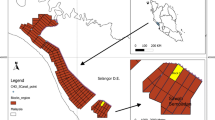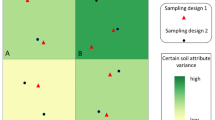Abstract
The definition of the distance between sampling grid points directly impacts the development of fertility maps because it affects the spatial dependence of geostatistics and the estimates for locations not sampled in the interpolation. Based on geostatistical concepts, it is common to recommend one or more soil samples per hectare. However, there is a need to understand how a cost-effective grid-sampling scheme can be developed to produce accurate digital maps. This study aimed to assess how + 5% and + 10% additional random points in the original sample grids affect the development of soil fertility maps under Brazilian Cerrado conditions. Four agricultural areas located in different states of Brazil were analyzed by applying the various sampling techniques. In total, 625 points were sampled, and ten sub-samples within 5 m of the central point were collected. Additional sampling points (+ 5% and + 10%) were randomly placed in the four quadrants of the field boundary following the original grid scheme. The soil attributes evaluated were pH, cation exchange capacity, base saturation, and Ca, Mg, K, and P contents. Geostatistical variograms were modeled for each field, attribute, and statistical sampling treatment. The best variogram model was selected based on the minimal difference between the root mean square error and average standard error of the cross-validation procedure, along with an evaluation of the root mean square standardized error value. The maps were compared using the relative deviation coefficients. The inclusion of additional 5% and 10% sampling points in the original grid was found to be effective in generating soil fertility maps, resulting in improved root mean square and average standard error values.







Similar content being viewed by others
Data Availability
The datasets used and/or analysed during the current study are available from the corresponding author on reasonable request.
References
Baio, F. H. R., Molin, J. P., & Povh, F. P. (2018). Agricultura de precisão na adubação de grandes culturas (Precision agriculture in fertilizing field crops). In R. M. Prado & C. N. S. Campos (Eds.), Nutrição e adubação de grandes culturas (Nutrition and fertilization of large crops) (pp. 350–379). FUNEP.
Baio, F. H. R., Neves, D. C., Alixame, D., Teodoro, P. E., Roque, C. G., & Oliveira, J. T. (2021). Agricultura de precisão: Mais assertivos (Precision agriculture: More assertive). Cultivar Máquinas, 19, 29–31.
Bhering, L. L. (2017). Rbio: A tool for biometric and statistical analysis using the R platform. Crop Breeding and Applied Biotechnology, 17, 187–190. https://doi.org/10.1590/1984-70332017v17n2s29
Bottega, E. L., Queiroz, D. M., Pinto, F. A. C., & Souza, C. M. A. (2013). Spatial variability of soil attributes in no a no-tillage system with crop rotation in the Brazilian savannah. Revista Ciência Agronômica, 44(1), 1–9. https://doi.org/10.1590/S1806-66902013000100001
Caon, D., & Genú, A. M. (2013). Mapping of chemical attributes in different sampling densities and influence on fertilization and liming. Revista Brasileira De Engenharia Agrícola e Ambiental, 17(6), 629–639. https://doi.org/10.1590/s1415-43662013000600009
Carneiro, J. D. S. S., Faria, Á. J. G., Fidelis, R. R., Silva Neto, S. P., Santos, A. C., & Silva, R. R. (2017). Diagnosis and management of spatial variability of soil fertility in the Cerrado. Scientia Agraria, 17(3), 38. https://doi.org/10.5380/rsa.v17i3.50096
Cherubin, M. R., Santi, A. L., Eitelwein, M. T., Amado, T. J. C., Simon, D. H., & Damian, J. M. (2015). Sampling grid size for characterization of the spatial variability of phosphorus and potassium in an Oxisol. Pesquisa Agropecuária Brasileira, 50(2), 168–177. https://doi.org/10.1590/s0100-204x2015000200009
Demattê, J. A. M., Demattê, J. L. I., Alves, E. R., Negrão, R., & Morelli, J. L. (2014). Precision agriculture for sugarcane management: A strategy applied for Brazilian conditions. Acta Scientiarum Agronomy, 36, 111–117. https://doi.org/10.4025/actasciagron.v36i1.17664
Dias, F. P. M., Castro, J. R., Nunes, F. J., Nonato, A. C. R., Santos, D. N., Fé, J. A. R., Santos, D. N., & Nóbrega, J. C. A. (2017). Efficiency of sample knittings on the characterization of space variability of physical attributes of soil. Anuário Do Instituto De Geociências, 40, 31–36. https://doi.org/10.11137/2017_2_31_36
ESRI. (2023). Performing cross-validation and validation. Retrieved April 7, 2023, from https://desktop.arcgis.com/en/arcmap/latest/extensions/geostatistical-analyst/performing-cross-validation-and-validation.htm
Isaaks, E. H., & Srivastava, R. M. (Eds.). (1990). An introduction to applied geostatistics. Oxford University Press.
Kerry, R., & Oliver, M. A. (2007). Comparing sampling needs for variograms of soil properties computed by the method of moments and residual maximum likelihood. Geoderma, 140(4), 383–396. https://doi.org/10.1016/j.geoderma.2007.04.019
Kerry, R., Oliver, M. A., & Frogbrook, Z. L. (2010). Sampling in precision agriculture. In M. A. Oliver (Ed.), Geostatistical applications for precision agriculture (pp. 35–63). Springer. https://doi.org/10.1007/978-90-481-9133-8_2
Lark, R. M., & Marchant, B. P. (2018). How should a spatial-coverage sample design for a geostatistical soil survey be supplemented to support estimation of spatial covariance parameters? Geoderma, 319, 89–99. https://doi.org/10.1016/j.geoderma.2017.12.022
Lundgren, W. J. C., Silva, J. A. A., & Ferreira, R. L. C. (2017). Accuracy of the kriging error estimate through cross validation. Floresta e Ambiente, 24, e00124114. https://doi.org/10.1590/2179-8087.124114
Matheron, G. (1963). Principles of geostatistics. Economic Geology, 58(8), 1246–1266. https://doi.org/10.2113/gsecongeo.58.8.1246
Mirzaee, S., Ghorbani-Dashtaki, S., Mohammadi, J., Asadi, H., & Asadzadeh, F. (2016). Spatial variability of soil organic matter using remote sensing data. CATENA, 145, 118–127. https://doi.org/10.1016/j.catena.2016.05.023
Molin, J. P., & Tavares, T. R. (2019). Sensor systems for mapping soil fertility attributes: Challenges, advances, and perspectives in brazilian tropical soils. Engenharia Agrícola, 39(9), 1809–4430. https://doi.org/10.1590/1809-4430-Eng.Agric.v39nep126-147/2019
Montgomery, D. C., & Peck, E. A. (2001). Introduction to linear regression analysis (3rd ed.). Wiley.
Moraes, D. A. C., Spadotto, C. A., Da Sartori, A. A. C., & Zimback, C. R. L. (2016). Spatial variability of groundwater contamination risk by tebuthiuron in sugarcane area. Pesquisa Agropecuária Brasileira, 51(12), 1992–1999. https://doi.org/10.1590/s0100-204x2016001200010
Resende, A. V., & Coelho, A. M. (Eds.). (2017). Amostragem para mapeamento e manejo da fertilidade do solo na abordagem de Agricultura de Precisão (Sampling for soil fertility mapping and management in the precision agriculture approach). Embrapa Milho e Sorgo.
Santos, C. L. R., Flores, R. A., Leal, A. J. F., Maranhao, D. D. C., Baio, F. H. R., & Arruda, E. M. (2016). Critérios para amostragem de solo (Criteria for soil sampling). In R. A. Flores & P. P. Cunha (Eds.), Práticas de manejo do solo para adequada nutrição de plantas no cerrado (Soil management practices for adequate plant nutrition in the cerrado) (pp. 107–124). UFG.
Starks, T. H. (1986). Determination of support in soil sampling. Mathematical Geology, 18(6), 529–537. https://doi.org/10.1007/BF00914253
Teixeira, P. C., Donagema, G. K., Fontana, A., & Teixeira, W. G. (2017). Manual de Métodos de Análise de Solo (Manual of soil analysis methods) (2nd ed.). Embrapa.
Tukey, J. W. (1977). Exploratory data analysis. Addison-Wesley series in behavioral scienceAddison-Wesley Pub. Co.
van Beers, W. C. M., & Kleijnen, J. P. C. (2003). Kriging for interpolation in random simulation. Journal of the Operational Research Society, 54(3), 255–262. https://doi.org/10.1057/palgrave.jors.2601492
Wadoux, A. M. J. C., Marchant, B. P., & Lark, R. M. (2019). Efficient sampling for geostatistical surveys. European Journal of Soil Science, 70(5), 975–989. https://doi.org/10.1111/ejss.12797
Yamamoto, J. K., & Landim, P. M. B. (2013). Geoestatística: conceitos e aplicações (Geostatistics: Concepts and applications). Oficina de Textos.
Acknowledgements
The authors would like to thank the Universidade Federal de Mato Grosso do Sul (UFMS), Universidade do Estado do Mato Grosso (UNEMAT), Conselho Nacional de Desenvolvimento Científico e Tecnológico (CNPq) – Grant numbers 303767/2020-0, 309250/2021-8 and 306022/2021-4, and Fundação de Apoio ao Desenvolvimento do Ensino, Ciência e Tecnologia do Estado de Mato Grosso do Sul (FUNDECT) TO numbers 88/2021, and 07/2022, and SIAFEM numbers 30478 and 31333. This study was financed in part by the Coordenação de Aperfeiçoamento de Pessoal de Nível Superior - Brazil (CAPES) – Financial Code 001.
Author information
Authors and Affiliations
Corresponding author
Additional information
Publisher’s Note
Springer Nature remains neutral with regard to jurisdictional claims in published maps and institutional affiliations.
Supplementary Information
Below is the link to the electronic supplementary material.
Rights and permissions
Springer Nature or its licensor (e.g. a society or other partner) holds exclusive rights to this article under a publishing agreement with the author(s) or other rightsholder(s); author self-archiving of the accepted manuscript version of this article is solely governed by the terms of such publishing agreement and applicable law.
About this article
Cite this article
Baio, F.H.R., Alixame, D., Neves, D.C. et al. Adding random points to sampling grids to improve the quality of soil fertility maps. Precision Agric 24, 2081–2097 (2023). https://doi.org/10.1007/s11119-023-10031-x
Accepted:
Published:
Issue Date:
DOI: https://doi.org/10.1007/s11119-023-10031-x




